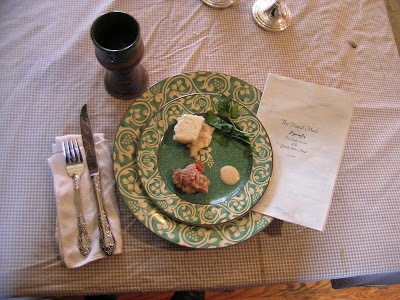Seder Meal
 This is probably the moment to confess I am an ardent Philosemite. I love the Jewish people, Judaism, and anything remotely Jewish. I don't know why -- I just get excited whenever I encounter Jews or Judaism. I've never lost my childhood delight in Jewishness, and I am perpetually in mourning for only being a "spiritual Semite," not a genuine one.
This is probably the moment to confess I am an ardent Philosemite. I love the Jewish people, Judaism, and anything remotely Jewish. I don't know why -- I just get excited whenever I encounter Jews or Judaism. I've never lost my childhood delight in Jewishness, and I am perpetually in mourning for only being a "spiritual Semite," not a genuine one.While I was growing up, my parents always held a Pascal Meal, a Catholic version of the Jewish Seder meal, during Holy Week. This is one tradition that we've been happy to pass on to our children. On Wednesday night, we gather with other families and hold the Passover service. The prayers we use are a version I admit I compiled myself, using several different Passover services and melding together the elements I liked best (all the while feeling a holy fear of being so cavalier with ancient tradition) and drawing out the Catholic foreshadowing in the Jewish prayers.
Following Doman tradition, our family prays the Passover service on Wednesday night, simply because rushing out to night Church service after holding an elaborate dinner was too exhausting. Our Seder meal has ten pages of prayers and readings, and it's a meal that deserves to be eaten slowly and with leisure to savor it.
This year was a hard year because of missing Joshua. Together with the stresses of current demands, if it had been up to me (and if I hadn't invited our friends over) I couldn't have done it. But this year Rose made the Haroset (apples peeled, chopped fine, and mixed with cinnamon and wine to resemble the mud of the Egyptian bricks), as well as a tasty kiwi-mint-and-honey relish for the lamb (not traditional, but we love it!). And my son Caleb made the Matzo (unleavened bread) of flour, olive oil, salt and water. And my friends helped me set the table. I forgot to take a picture but I set up a plate above so you could see what it looks like. The other items on the plate are Moror (horseradish, symbolizing the bitterness of slavery and sin) and the green herb (a friend made a seven-herb salad for the Seven Sorrows of Mary), which is eaten dipped in salt water to symbolize tears and hope.
If you haven't ever done a Seder meal, consider it! Holy Thursday is the traditional night to do it. Mary Reed Newland had a very very short version of it in The Year and Our Children. You can find another short version at CatholicCulture.org. They have directions for making the Seder foods here.


Comments
I'm a mommy to a 7mo old bouncing baby boy and a Christendom alumni. I *love* your posts - they are so inspirational to me in my quest for a simple and beautiful family life. I especially love your plastic elimination post :)
But I do have a question. My husband and I are renting a cozy home and though we love decorating for holidays, we find it hard to store these (and other) items in the meantime. Do you have any suggestions? :)
Thanks and God Bless!
~Laura (Williams) Ross
I have been enjoying your pictures of beauty. I loved the comparison of the fence with our walk with God. I also really enjoyed seeing your little one exploring in the water!
A blessed Holy Week to you and yours...
It is a wonderful experience, isn't' it? Amazing to see how Jesus is all over the Seder. (And then when I read, as in the local paper's food section this week, that the Afikomen represents "the brokenness of man," I want to scream, "No! It's the body of Christ, broken for you!")
So glad you do this. Praying for you during Holy week.
LeeAnn- I actually was thinking of publishing 'our' version on lulu.com just for fun. But I have to go through it and clean it up a bit first - every year we still have to work around my typos!
Laura,
Thanks for your question! I'll see if I can cover it in another post!
Meredith Gould has written a very good book, "Come the The Table; A Catholic Passover Seder for Holy Week." Meredith is a convert from Judaism and spend several years pondering, considering, researching and testing to put this book together. I highly recommend it.
Though OUR family's Jewish-convert friend (from South Africa - I am nagging him to write his memoirs - he actually KNEW Alan Paton!) says that Merdith's version doesn't include the part he remembers most fondly from his childhood, the Dayenu (the "It would have been enough!" bit when you splash wine on your napkin...)
(If I may be allowed a short advertisement - if not remove this part) The Haggadah in "Lent and Easter in the Domestic Church" does include the Dayenu, and is a fairly short and simple ceremony for families.
Regardless of which Haggadah you use, this is a wonderful tradition and devotion that should be more common. I like the Wednesday night idea - it is difficult to manage doing it on Holy Thursday. We have occasionally held our Seder Supper on Palm Sunday evening.
Catherine